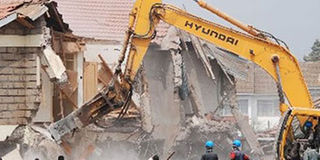Kenya Power targets over 2,000 houses near electricity lines

Members of the public watch as a bulldozer demolishes a building in Lang’ata, Nairobi, on July 20, 2013. PHOTO | FILE | NATION MEDIA GROUP
What you need to know:
Last week, Mr Kigen said the exercise was done in some parts of Buruburu Farmers land where about 700 structures were torn down.
The power firm says there are thousands of buildings illegally built on wayleaves that stretch 5,300km countrywide.
Other areas mapped for demolition include Umoja Phase 1, Inner Core, Tena, Embakasi Baraka Estate to Tassia Estate, Mathare Valley slums.
Demolitions of illegal structures on power line reserves by Kenya Power enters its second week on Monday with at least 2,000 more buildings on their main power line targeted.
Kenya Power Security Services Manager Geoffrey Kigen said that the operation, dubbed Ondokea Laini, resumed this week after a long hiatus.
He said that about 700 illegal structures were flattened last week.
This week they will be tearing down illegal structures in Mihang’o, Mowlem and Dandora power substation.
“We gave them notices in December last year, done sensitisations, marked the buildings on the wayleaves and told the owners to remove them. Apparently some had not done so and those are the ones we are removing. This week we will concentrate on the main KPLC line,” said Mr Kigen.
WAYLEAVES
A wayleave is a right of way over the land of another and is designed for carrying sewer, drain, power line or pipeline into, through, over or under any lands.
Last week, Mr Kigen said the exercise was done in some parts of Buruburu Farmers land where about 700 structures were torn down.
Kenya Power guidelines allow structures built 20 metres on either side of a 220kV power line and 15 metres on either side of a 132kV line.
“It is a multi-agency operation involving over 20 government agencies that have wayleaves which has been ongoing on unsafe buildings in Nairobi. We have removed thousands of such illegal structures and we have around 2, 000 structures pending,” he said.
MAPPED AREAS
The power firm says there are thousands of buildings illegally built on wayleaves that stretch 5,300km countrywide.
At least 10,000 such structures extending 6km have been removed in Imara Daima, Mukuru kwa Njenga, Mukuru kwa Reuben and Sinai village.
Other areas mapped include Umoja Phase 1, Inner Core, Tena, Embakasi Baraka Estate to Tassia Estate, Mathare Valley slums.
The demolition exercise was first launched in March with the first phase carried out in Embakasi through Mukuru slums to Enterprise Road over an eight-kilometre stretch.
So far, 15,250 unsafe structures, many of them in informal settlements, have been cleared in Nairobi.
Mr Kigen said Kenya Power’s wayleaves have been encroached on by squatters who have put up illegal structures under its power lines, compromising its ability to deliver electricity to its customers throughout the country.
“The illegal and unsafe structures not only pose a danger to the squatters in the event of an electrical accident, but also deny us the ability to maintain our power supply lines,” he said.
The agencies involved in the operation include the Nairobi City County Government, the National Building Inspectorate, the National Construction Authority, the National Environment Management Authority, the National Disaster Management Unit, Kenya Pipeline Corporation, Kenya Railway Corporation, Water Resource Authority, and the National Police Service.





